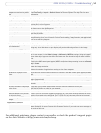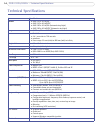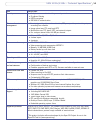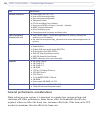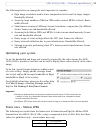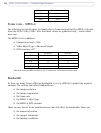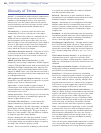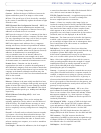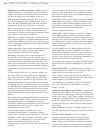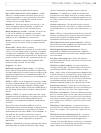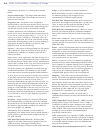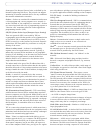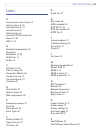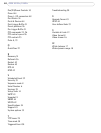
63
AXIS 231D+/232D+ - Glossary of Terms
and among commercial application developers.
MAC address (Media Access Control address) - A MAC
ad
dress is a unique identifier associated with a piece of
networking equipment, or more specifically, its interface
with the network. For example, the network card in a
computer has its own MAC address.
Manual iris - This is the opposite to an autoiris, i.e. the
c
amera iris must be adjusted manually to regulate the
amount of light allowed to reach the image sensor.
Mbit/s (Megabits per second) - A measure of the bit rate,
i.e
. the rate at which bits are passing a given point.
Commonly used to give the "speed" of a network. A LAN
might run at 10 or 100 Mbit/s. See also Bit rate.
Monitor - A monitor is very similar to a standard television
set, but
lacks the electronics to pick up regular television
signals.
Motion JPEG - Motion JPEG is a simple
c
ompression/decompression technique for networked video.
Latency is low and image quality is guaranteed, regardless
of movement or complexity of the image. Image quality is
controlled by adjusting the compression level, which in turn
provides control over the file size, and thereby the bit rate.
High-quality individual images from the Motion JPEG
stream
are easily extracted. See also JPEG.
Megapixel - See Pi
xel.
MPEG (Moving Picture Experts Group) - The Moving
Pic
ture Experts Group develops standards for digital video
and audio compression. It operates under the auspices of the
International Organization for Standardization (ISO). The
MPEG standards are an evolving series, each designed for a
different purpose.
MPEG-2 - MPEG-2 is the designation for a group of audio
an
d video coding standards, and is typically used to encode
audio and video for broadcast signals, including digital
satellite and Cable TV. MPEG-2, with some modifications, is
also the coding format used by standard commercial DVD
movies.
MPEG-4 - MPEG-4 is a group of audio and video coding
stand
ards and related technology. The primary uses for the
MPEG-4 standard are web (streaming media) and CD
distribution, conversational (videophone), and broadcast
television.
Most of the features included in MPEG-4 are left to
ind
ividual developers to decide whether to implement them
or not. This means that there are probably no complete
implementations of the entire MPEG-4 set of standards. To
deal with this, the standard includes the concept of
"profiles" and "levels", allowing a specific set of capabilities
to be defined in a manner appropriate for a subset of
applications.
Multicast - Bandwidth-conserving technology that reduces
ba
ndwidth usage by simultaneously delivering a single
stream of information to multiple network recipients.
Multiplexer - A multiplexer is a high-speed switch that
provides full-
screen images from up to 16 analog cameras.
Multiplexers can playback everything that happened on any
one camera with no interference from the other cameras on
the system.
Network connectivity - The physical (wired or wireless)
and logica
l (protocol) connection of a computer network or
an individual device to a network, such as the Internet or a
LAN.
NWay - NWay is a telecommunications protocol used with
Etherne
t networking devices (such as router and switch) to
automatically negotiate the highest possible common
transmission speed between two devices.
NTSC (National Television System Committee) - NTSC is
the
television and video standard in the United States. NTSC
delivers 525 lines at 60 half-frames/second.
OEM (Original Equipment Manufacturer) - This is a
designatio
n for companies that manufacture equipment
which is then marketed and sold to other companies under
their own names.
PAL (Phase Alternating Line) - PAL is the dominant
television
standard in Europe. PAL delivers 625 lines at 50
half-frames/second.
PEM (Privacy Enhanced Mail) - An early standard for
se
curing electronic mail. The PEM-format is often used for
representing an HTTPS certificate or certificate request.
Ping - Ping is a basic network program used diagnostically
to chec
k the status of a network host or device. Ping can be
used to see if a particular network address (IP address or
host name) is occupied or not, or if the host at that address
is responding normally. Ping can be run from e.g. the
Windows Command prompt or the command line in Unix.
Pixel (Picture element) - A pixel is one of the many tiny
dots
that make up a digital image. The color and intensity of
each pixel represents a tiny area of the complete image.
PoE (Power over Ethernet) - Power over Ethernet provides
powe
r to a network device via the same cable as used for the
network connection. This is very useful for IP-Surveillance
and remote monitoring applications in places where it may
be too impractical or expensive to power the device from a
power outlet.
PPP (Point-to-Point Protocol) - A protocol that uses a
se
rial interface for communication between two network
devices. For example, a PC connected by a phone line to a
server.
PPTP (Point-to-Point Tunnelling Protocol) - A protocol
(s
et of communication rules) that allows corporations to
extend their own corporate network through private
"tunnels" over the public Internet. In this way a corporation
can effectively use a WAN (Wide Area Network) as a large
single LAN (Local Area Network). This kind of



